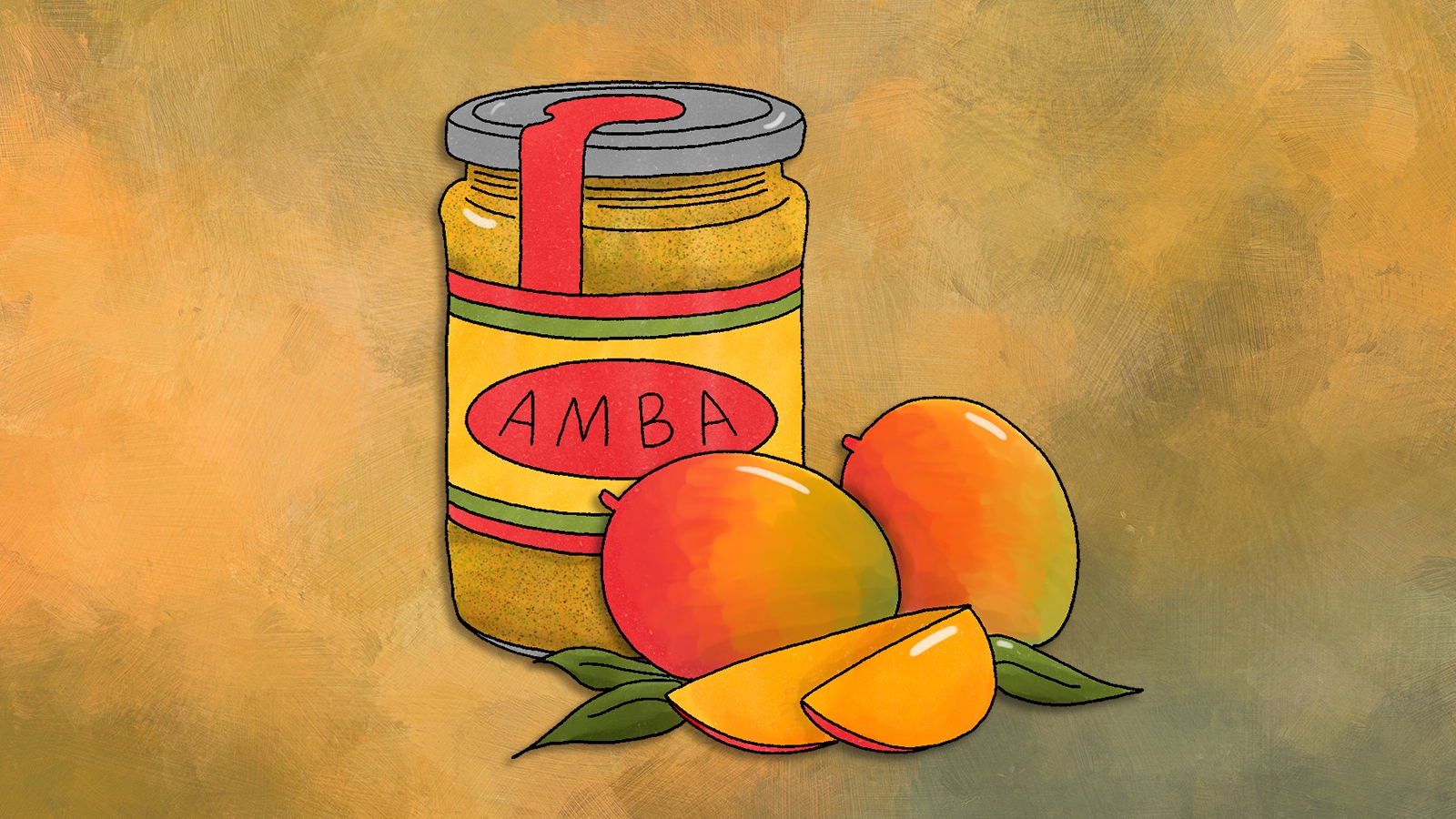If you’ve ever ordered a falafel and wondered what the funky, yellowish-orange liquid in the squeeze bottle next to the tahini is, you’re not alone. For years, I would dismiss the condiment out of fear and ignorance. Just the sight of it got my tongue tingling. One day, I decided to face my fears and dive headfirst into the amba pool. Since then, I’ve been championing the Baghdadi mango condiment and speaking its praises to any audience I can find.
It Takes Two to Amba
Amba, a savory mixture of fenugreek, vinegar, turmeric and mango, is as contentious as it is mouthwatering. According to legend, the condiment was invented in the late 19th century by members of the Sassoons, a wealthy Iraqi Jewish family residing in Bombay who became fascinated by India’s mango chutneys.
Wanting to share their discovery with their community back home in Iraq, who had never seen mangoes before, they decided to send barrels of them soaked in vinegar. Upon arrival in Basra, Iraq, the barrels full of pickled mangoes were greeted with skepticism. Ultimately, good taste prevailed, and amba became a national staple in Iraq. It’s often used to top seafood platters, and if you visit Baghdad’s Abou Al-Nawas Street you’re to find one of the city’s most famous dishes: wood-grilled Masghouf (Tigris trout) coated with amba.
While the condiment pays homage to its roots (amba means “mango” in Marathi — the language spoken in the Indian state of Maharashtra), it differs from Indian mango chutneys in numerous ways. Notably, amba uses unripe, green mangoes, which make for a tangier flavor than its sweet Indian counterparts.
The Nosher celebrates the traditions and recipes that have brought Jews together for centuries. Donate today to keep The Nosher's stories and recipes accessible to all.
DOA: Delicious Upon Arrival
Upon their immigration to Israel in the 1950s, Iraqi Jewry brought their prized sauce with them. Amba had traditionally played a large role in traditional Iraqi Jewish Shabbat breakfast, where it balanced the rich fried eggplant and slow-cooked eggs that made up some of the spread. In Israel, this breakfast was packed into a pita to be eaten on-the-go, anytime. This sandwich, called sabich, has become one of the country’s most popular street foods.
Amba is also ever-present in other popular street food, like falafel and shawarma, where its tartness provides the perfect compliment for juicy meat and crispy fried falafel. My personal favorite use for it is as a ketchup substitute over French fries.
But, really, there’s no limit to amba’s role in the Israel kitchen.
Israeli celebrity chef Meir Adoni told Haaretz, “We use amba as a spice and as a raw material for all purposes, just like soy and ginger. Amba is the Middle Eastern equivalent of umami. It’s all because of the hilbeh (fenugreek paste), which creates a crazy mixture of emotions and flavors. It’s addictive, and for me, it’s one of the flavors that are identified with who we are in the Middle East.”
During the 1991 Gulf War, Israeli soldiers would joke that when Iraqi leader Saddam Hussein fired missiles at Iraqi Jewish neighborhoods, he was using amba-seeking missiles. Which actually might be a good way to find falafel stands worth their salt.
La Amba
Nowadays, you can find amba anywhere from your local shawarma shop to being elevated in fine dining establishments worldwide. (You can even make it at home or pick it up at Trader Joe’s.)
To understand how amba transitioned from street food fare to fine dining, we need to realize just how unique a flavor amba is.
Asaf Granit, the Gordon Ramsay of Israeli cooking, explains what makes the condiment so culturally significant: “Amba is a very precise indicator of our cuisine in Israel. Nearly everything we call modern Israeli cuisine is a result of crossing one boundary or another. This refers to different waves of immigration, different neighborhoods in major cities, and to different communities. There are many such influences that create dishes or specific food cultures, and amba is an amazing example of this. Here in Israel, it took root mainly as a spice for grilled internal organs (liver or Jerusalem mixed grill), beyond its home use as a paste. The wider public recognizes it as a flavor, as a kind of umami. It enhances everything with its intensity.”
Amba has become an integral part of Israeli society; it even made a mark in pop culture with The TeaPacks’ 2003 hit “Rikudei Amba,” meaning “Pickled Mango Dances.” So, next time you order a sabich or falafel, don’t skip out on the amba. It might have you dancing all the way home with its electrifying umami flavors.
If you’d like to make amba at home, try out our recipe.



